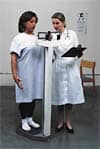The AASM’s new practice parameters for oral appliance therapy opens opportunities for the field of dental sleep medicine.
Sleep disordered breathing (snoring and obstructive sleep apnea) affects tens of millions of people worldwide. Obstructive sleep apnea (OSA) alone may afflict as many as 17% of Americans1 and is expected to approach 20% in the next few years due to the increase in obesity. Over the past 15 years, adequately trained dental professionals have emerged as key players in the treatment mix of this serious malady. By working closely with medical colleagues, dentists have been able to create and maintain patent upper airways in many patients to allow for adequate breathing and sleep.
This past February, the American Academy of Sleep Medicine published a revision of its 1995 review paper and practice parameters for the treatment of snoring and OSA with oral appliances.2 As before, the Academy found the use of oral appliances to be a necessary and effective mode of therapy for these disorders. This most recent scientific review focuses on several hundred studies (versus several dozen in the 1995 paper) and includes a preponderance of higher evidence levels than previously analyzed. Furthermore, the practice parameters outline recommendations regarding the use of oral appliances as reflected in the outcomes of the studies reviewed.
It is wholly incumbent on any dental practitioner who treats snoring and OSA to be familiar with the entire content and to practice within the recommendations as published. Adhering to practice protocols that are unsupported by scientific outcome studies can be dangerous and may increase the likelihood of inadequate therapy, which can place patients at greater risk for comorbid sequelae including hypertension, heart attack, stroke, and depression.3-7 In addition, poorly managed OSA takes its toll on society and industry. Research has documented that patients with OSA are involved in traffic accidents two to three times more often than the general population8 and are at increased risk for injury in the workplace.9 Finally, the prevalence of undiagnosed moderate-to-severe sleep apnea in middle-aged adults suggests that untreated OSA may cause $3.4 billion in additional medical costs in the United States.10
These revised practice parameters specifically highlight the need for proper clinical expertise in this new field of dental sleep medicine. Presently, various educational opportunities are available for dentists, ranging from commercial venues to an independent professional dental organization, the Academy of Dental Sleep Medicine. While commercial concerns are often beneficial because they offer workshops and lectures that present the novice with a good entry point, occasions may arise where the information is influenced by financial gain and deviates from accepted medical protocol. This can lead to improper therapy for patients and legal exposure for the dentist. Conversely, a nonprofit, professional, academic, clinical, and educational organization can provide the serious clinician with objective material that is based on current research and is congruent with the contemporary medical model. Over time, experienced clinicians can attain diplomate status through the American Board of Dental Sleep Medicine. Ultimately, practitioners must tread cautiously among the educational venues so that an effective foundation is created upon which to practice.
While it is beyond the scope of the practice parameters, the legal implications loom large in the practice of dental sleep medicine. A physician or dentist who exceeds the scope of professional licensure risks civil and criminal liability. Additionally, one who practices within the scope of licensure but does not satisfy the standard of care applicable to a given procedure also risks liability. Presently, treatment of snoring and OSA must be a team effort. Diagnosis falls within the realm of medicine, while the management of oral appliances dwells within that of dentistry. If each practitioner performs within the scope of licensure and standard of care, patients will be more likely to receive effective treatment and legal liabilities will be minimized.
Robert R. Rogers, DMD, is the director of dental medicine for St. Barnabas Medical Center in Gibsonia, Pa. He is the founding president of the Academy of Dental Sleep Medicine (ADSM). In addition to being a member of the ADSM board of directors for 10 years, he chaired the education and curriculum committee for 6 years and was the director of the ADSM Resource Center for 12 years. Rogers is a diplomate of the American Board of Dental Sleep Medicine and a recipient of the ADSM Distinguished Service Award.
References
1. Young T, Peppard PE, Taheri S. Excess weight and sleep-disordered breathing. J Appl Physiol. 2005;99:1592-1599.
2. Kushida CA, Morganthaler T, Littner M. Practice parameters for the treatment of snoring and obstructive sleep apnea with oral appliances: an update for 2005. Sleep. 2006;29:240-243.
3. Krieger AC, Redeker NS. Obstructive sleep apnea syndrome: its relationship with hypertension. J Cardiovasc Nurs. 2002;17: 1-11.
4. Smith R, Ronald J, Delaive K. What are obstructive sleep apnea patients being treated for prior to this diagnosis? Chest. 2002;121: 164-172.
5. Moore T, Franklin KA, Holstrom K. Sleep disordered breathing and coronary heart disease: long-term prognosis. Am J Respir Crit Care Med. 2001;164:1910-1913.
6. Shahar E, Whitney CW, Redline S. Sleep disordered breathing and cardiovascular disease: cross-sectional results of the Sleep Heart Health Study. Am J Respir Crit Care Med. 2001;163:5-6, 19-25.
7. Saito T, Yoshikawa T, Sakamoto Y. Sleep apnea in patients with acute myocardial infarction. Crit Care Med. 1991;19:938-941.
8. Horstmann S, Hess CW, Bassetti C. Sleepiness related accidents in sleep apnea patients. Sleep. 2000;23:383-389.
9. Ulfberg J, Carter N, Edling C. Sleep-disordered breathing and occupational accidents. Scand J Work Environ Health. 2000;26: 237-242.
10. Kapur V, Blough DK, Sandblom RE. The medical cost of undiagnosed OSA. Sleep. 1999;22:749-755.





